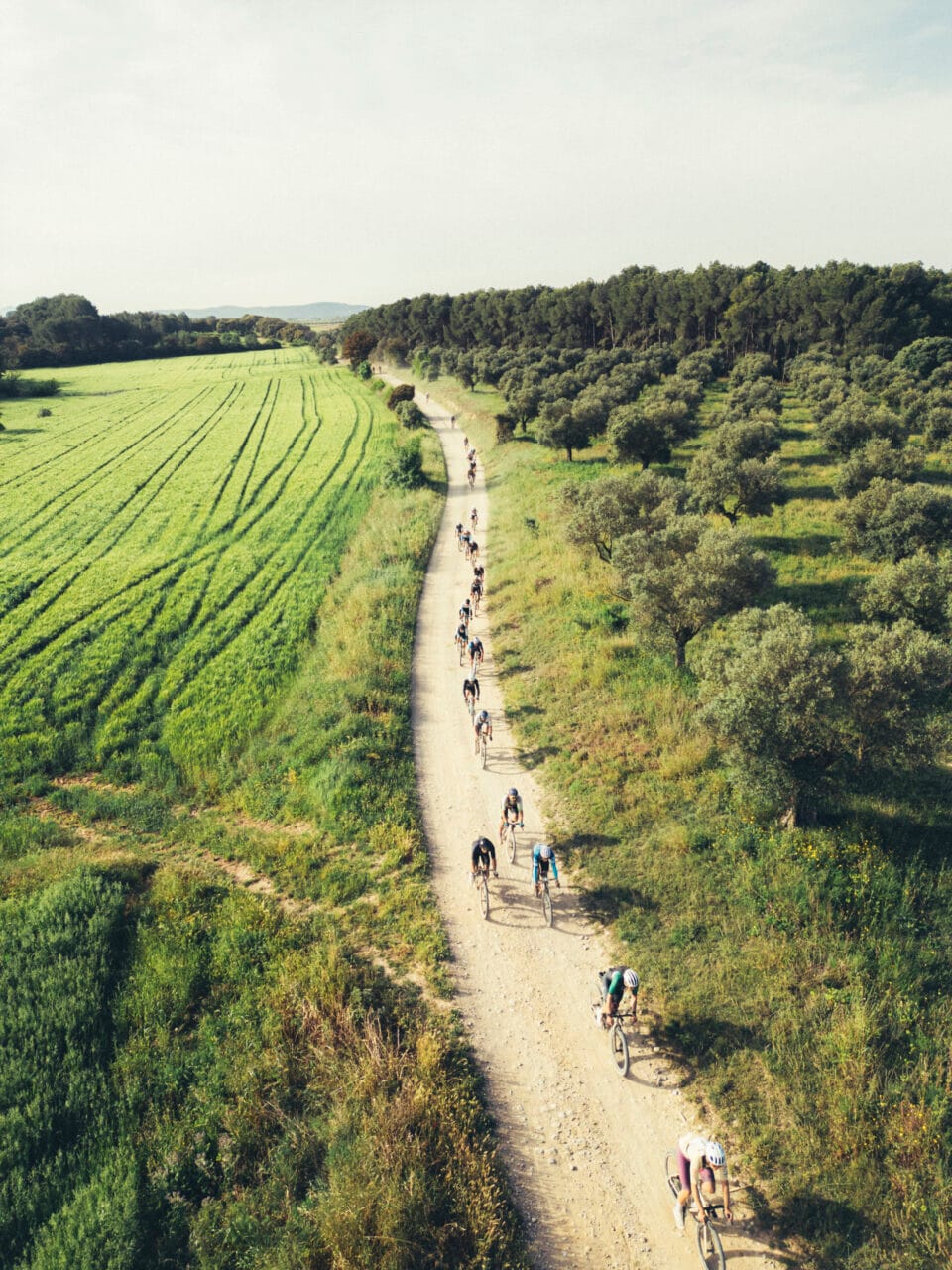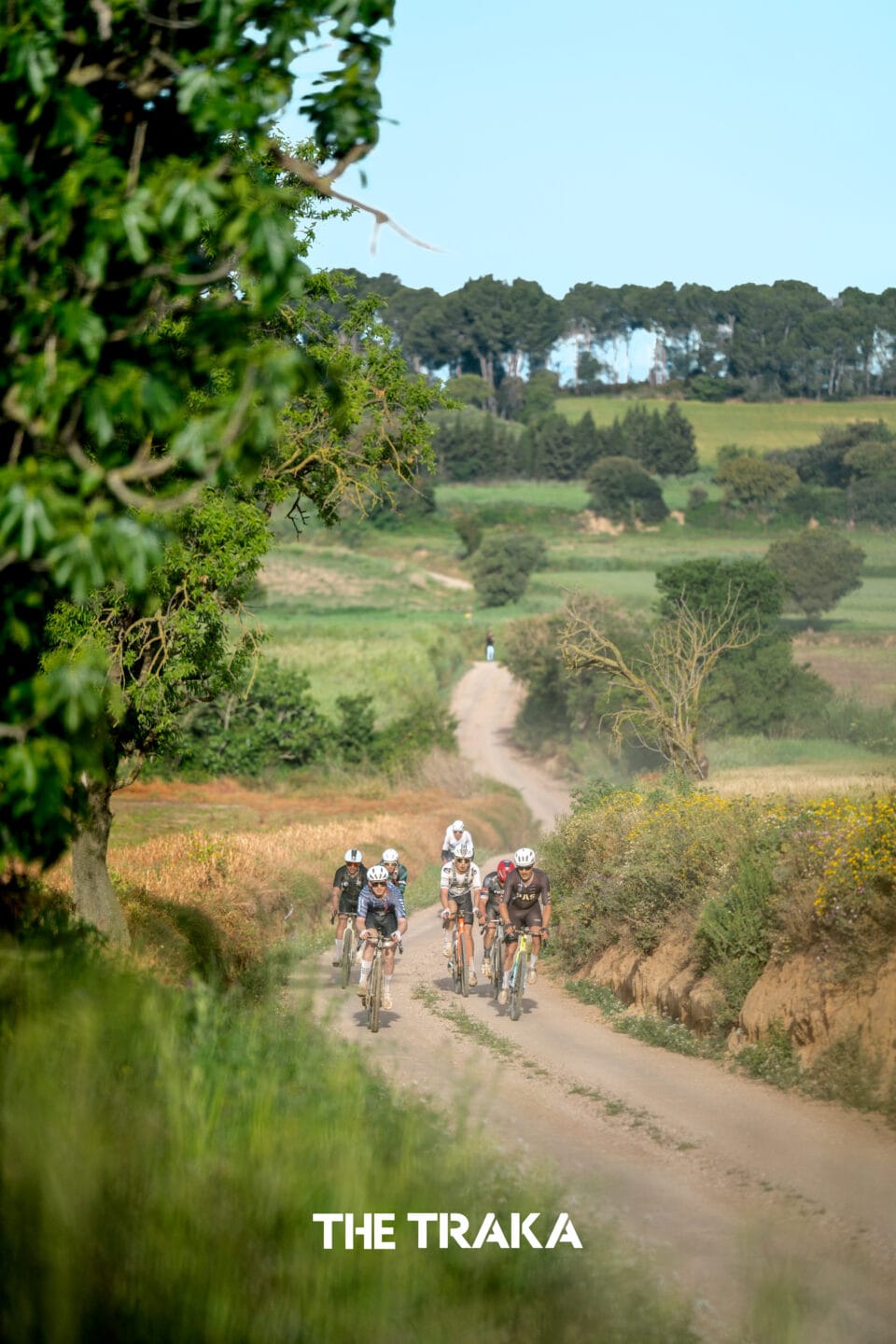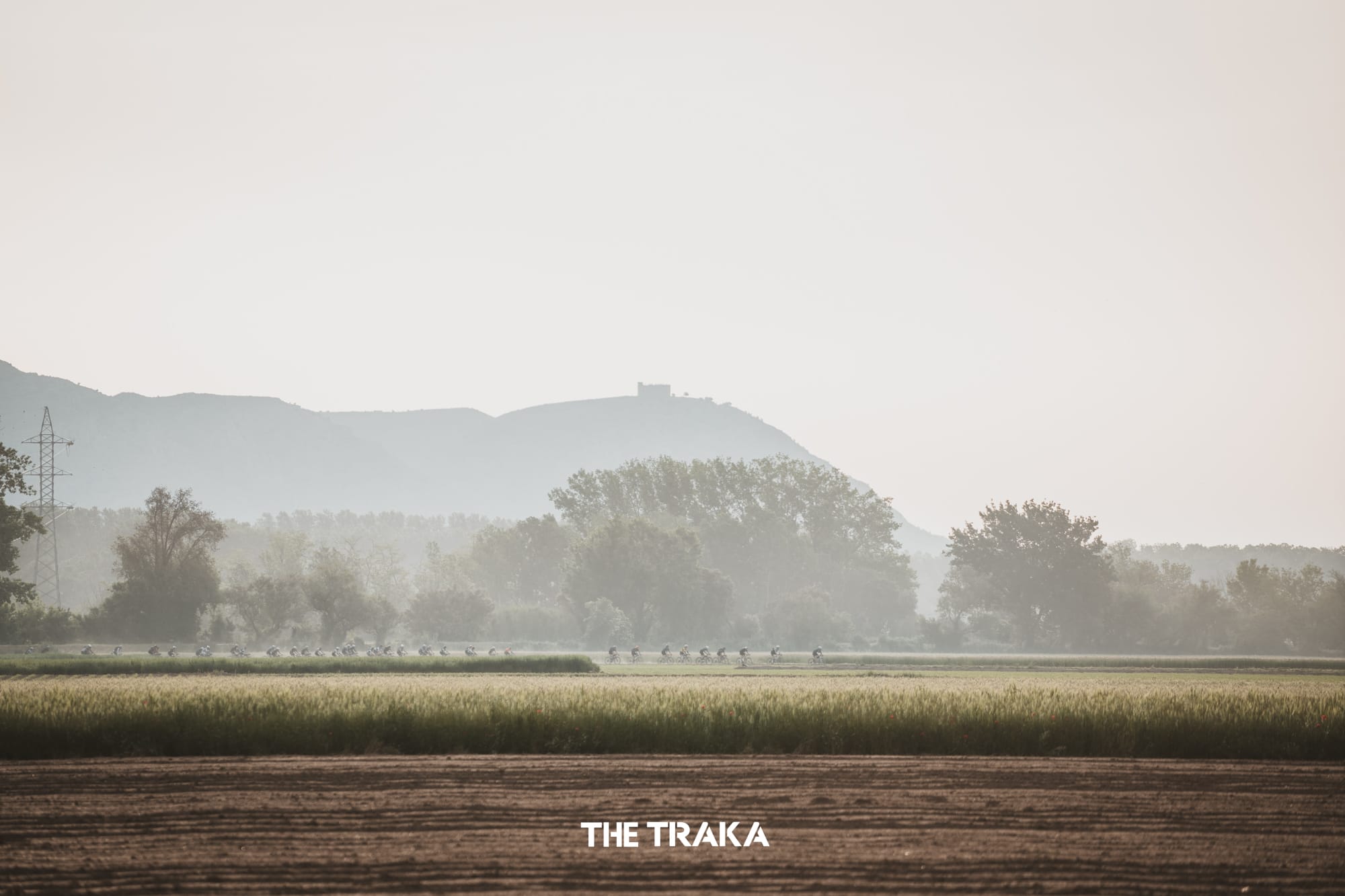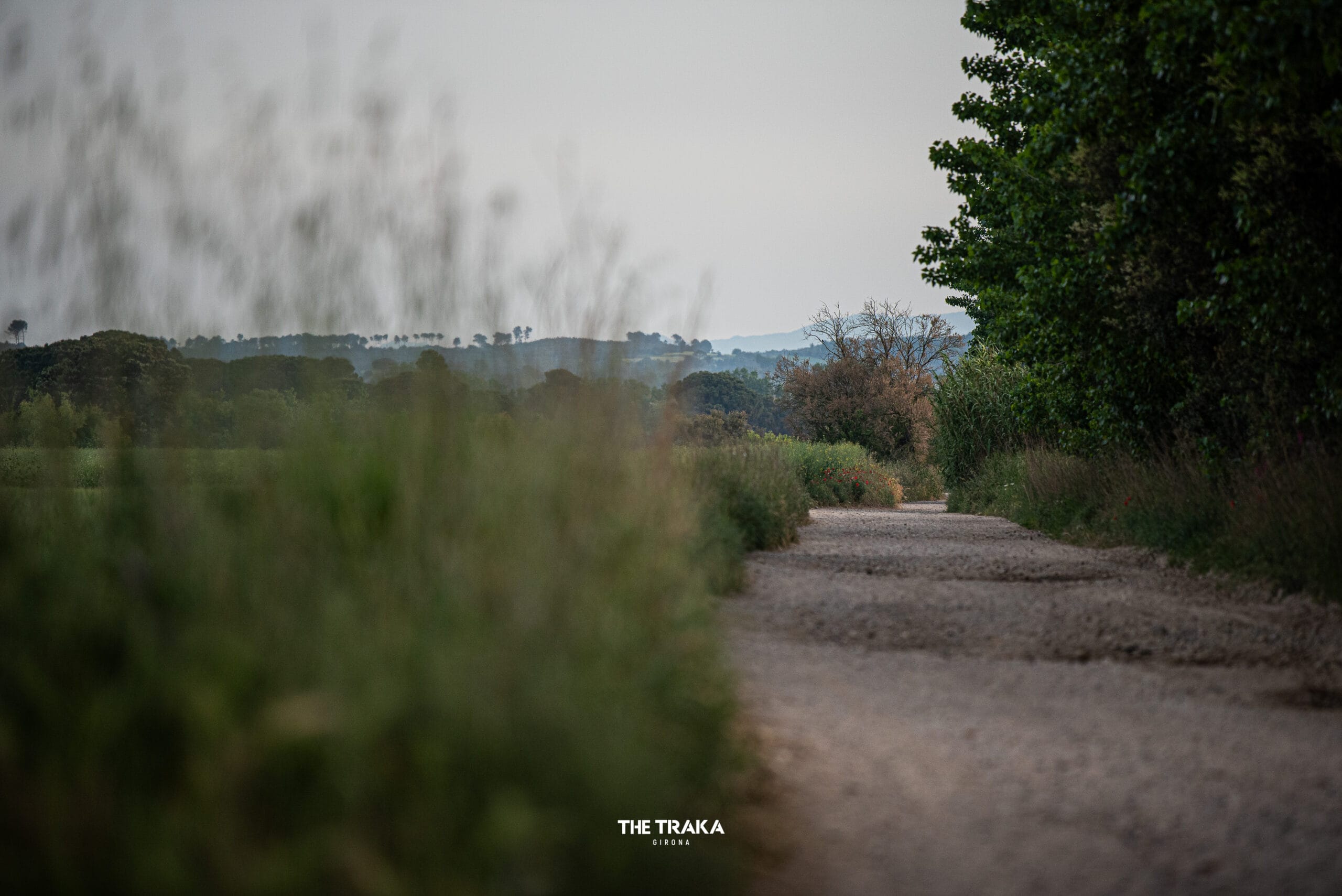
– Welcome to Traka! This is your moment! the speaker blasts as the race begins. It’s 5:50 AM, still pitch black, except for an ocean of red and white lights from the 800 riders at the start at The Traka 360 – arguably the biggest European gravel race.

I’m not entirely sure what I’ve gotten myself into. Last year, I raced the 200k, followed by 100k the next day, but that was spread out over two days. This year, I’ve signed up for the 360k route—a non-stop race with just a few aid stations. While the 200k might attract just as many of the top riders, the 360k is the true heart of The Traka.
Swick! The rider in front of me brakes suddenly, and I just manage to avoid his wheel. The pace is steady from the start as we climb the asphalt road out of Girona. It’s still dark, and even though the headlights illuminate the riders ahead, you have to stay focused. Easier said than done at this hour. But I’m sure I’ll wake up soon enough.

The first sunbeams hit me, and it’s an instant surge of energy. As the light slowly grows, I glance down at my brand-new Felt Breed Advanced, which I’m riding for the first time after a quick test ride yesterday. The bike feels fast, and I immediately click with it. I’m running DT Swiss GR1400 wheels paired with Challenge Getaway 45 tires, and they feel just right on the road.
My new Bryton S810 head unit tells me we are about to make a sharp right turn, and next we are led into a narrow singletrack where the peloton stretches out ahead. Suddenly, gaps open, and I’m forced to bridge across to the first 30 riders. I make it, but I know—this is where it gets serious. We’re barely 40 kilometers into the race, with more than 320 to go. Early mistakes like these can ruin your whole race, and these early bursts of effort are going to come back to bite later on.
A few riders have already opened a gap on the front group. As I move up, a rider from PAS and one from Tudor attack. My gut tells me to follow—they’re strong, part of a team, and it could be the right move. A couple more riders jump from the bunch, and before long, we form an eight-man breakaway, pulling away with a solid gap from the peloton.

Racing aggressively was never part of my plan, but now, I realize this could be my ticket to the finish. The first big hurdle is the big climb ahead, but if I can make it through that, the road to the finish might be a little easier.
We’re flying, and just a few kilometers later, we catch up to four riders who had been in the lead. Now, we’ve formed the front group. I spot fellow Norwegian Ole Bjørn Simingseth up ahead, and things are starting to look better.
Traka is never easy. The profile promises massive climbs that you know are going to hurt, but in between, it’s a constant rollercoaster of twisting trails. Keeping your momentum is key, but it’s also exhausting. Every micro-effort chips away at your energy storage. And then there’s the ever-present risk of punctures—or worse, a crash.

In the breakaway, the PAS rider is Nils Correvon. On the descent, he hits a sharp rock and…
– BAAM!
Nils gets a puncture and has to stop. Another rider gives up—he’s completely empty. Our 12-man group is now down to 8. I’m relieved to see Ole Bjørn is still with us. He’s a beast, and having someone in the group you know can hold the pace is comforting.
But then, on a tricky downhill, I hear the awful sound of a crash, followed by the unmistakable scream of pain. I don’t see the crash itself, but only five riders pass me after it. We roll through cautiously, hoping for good news, but we quickly realize we’ve lost three more riders.
With fewer of us now, it means more time in the wind and more energy spent. We keep pedaling, pushing forward. Only 20 kilometers to the aid station where I can finally resupply.

It’s getting hotter, but I enjoy it. After the chilly and dark morning, it’s nice to experience weather more familiar to Catalonia.
We come flying into the aid station at high speed, and I nearly miss my wife, Hanna, in the chaos. She’s out serving me bottles and nutrition. I quickly switch out my hydration vest, grab three bottles filled with electrolytes, and stuff my pockets with another three rice cakes and a gel from Nordic Nutrition. I’m stocking up, but something’s off—we’ve already covered 135 km, yet this aid station was supposed to be at 130 km.
The first two riders are faster than me, so I have to catch up. I make it up to the front just as we start the biggest climbs of the day.

My cadence drops as low as 40 as I grind my way up the climb of Mas Patiras – A 6k climb with 200 meters of elevation gain but with sections over 10%. The trail winds steeply through beautiful terrain, but there’s little room to enjoy it. All my focus is on maintaining momentum—one pedal stroke at a time.

I look over my shoulder and spot a fast-moving group gaining on me—the remnants of the peloton. I expected them to fly up this climb; only the strongest would be able to stay in contact.
The Tudor rider, Jan Stöckli, and another guy have managed to get a gap on me, leaving me in third position. I know that if I can reach the summit before the peloton swallows me up, I might earn a kind of free pass on the long, flat stretch heading south toward Girona.

As the gradient eases off at the top, they catch me. I latch onto the back of the group—about 15 riders strong. I recognize all the big names except Lachlan Morton, who must have run into some mechanical trouble.
We drop down the backside of the mountain for a few kilometers before a surprise hits me: a brutal 100-meter wall that forces everyone off their bikes. It’s steep, and the ground is so loose I can barely push my bike forward. No one’s moving fast, but halfway up, my legs stiffen to the point I can barely move. I am crawling uphill like a snail. I takes me 9 minutes, but finally I reach the top of the hike and can get back on the bike. I try to accelerate and catch up with the guys, but it is impossible. Chad Haga, who’s also on Felt, passes me and tell me to hang on. But sorry, hombre, no can do.





I want to stop. I want to call Hanna and have her come pick me up. But I don’t. I keep going, riding as if I’m out on a recovery spin. Eventually, a group of five riders catches up, and I just manage to hang on. And now it starts raining too.
It’s a hard reset—going from the front of the race to completely blowing up. The hike crushed me. I bonked, lost contact with the leaders, and any shot at staying up front slipped away. But I still have to make it back to Girona, and at least now, tucked into this group, I can hold a steady pace again.
We rotate smoothly, pushing through a chilly rainfall, fumbling with navigation. Slowly, we edge closer to the second aid station—my next checkpoint, my next small goal.

There’s Hanna and the Felt team. This time, I’m quicker off the mark and quickly catch up with three riders from our group. I’m starting to feel better now, able to push some decent watts again. But after just a few kilometers, we hit another tough climb—probably the biggest of the day.
Els Metges is 9 kilometers long with 360 meters of elevation gain. Once again, my 48T front chain turns this climb into a real grind. I struggle to keep the momentum, barely staying with the two fastest riders in our group. This climb is brutal, especially after 300 kilometers of racing. I try to find my rhythm, keeping the two guys within sight. At least the rain has stopped.

After a quick descent, we catch my American friend Griffin Easter. But soon enough, the two of us are forced to let the others go. Another low point in the race, and I’m barely moving forward.
The end is near. Many riders would probably feel like they’re about to collapse as we near the finish, but honestly, I’m in a new zone and feel strong.
At the same time, Lars van Coppenolle comes flying past me. I try to hang on, but with just 10 kilometers to go, I know we’re not finished yet.
– Left turn, my Bryton announces, and an unwelcome gravel climb looms ahead. It feels like a cruel joke after riding 350 kilometers, but there’s no turning back now. A final suffer fest with 2 kilometers of pain and 150 meters of elevation, the climb called Pujada de Can Gall. The Belgian disappears into the distance, and I focus on one pedal stroke at a time, just trying to get home. Almost there.

– ¡Felicidades, Jonas Orset! the announcer shouts as I cross the finish line. I made it. What a feeling!
I’m welcomed by the Felt team with smiles and pats on the back. I’m happy—really happy—but after riding for so many hours, it also feels strange to finally stop. 12 hours and 27 minutes. 27th place. I lost around 10 spots in the last 60 kilometers and had been part of the breakaway for the first 160. So the result doesn’t quite reflect the ride I had. A top 20 would’ve sounded better, sure—but finishing a race like this, being part of its story, feels incredible.

It’s going to take weeks, maybe even months, to fully absorb everything that happened out there. But the smile? That’s staying.
Thank you, Klassmark and the Gravel Earth Series, for an unforgettable Traka. I’ll be back next year.
